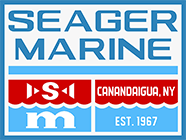5 Safety Tips for Boating in High Traffic Months
It’s no secret that August is one of the busiest months for boating, especially in Upstate New York. Tourists are flocking to the area, children are out of school, and the water is finally warm enough to spend more than a few minutes cooling off in. Everyone wants to get out on the water and make the most of those last few weeks of summer, especially boaters who patiently wait for boating season all winter long.
While the hustle and bustle makes August a very fun month on the water, it can also make it one of the more dangerous months on the water. This makes it even more imperative to be aware of your surroundings and to take extra caution when operating a boat.
Here are 5 safety tips to keep in mind all season long, but especially during high traffic months, such as August.
1. Drive at a "safe speed" at all times
With so many people on the water all at once, in other boats, on paddleboards, in kayaks, on jet skis, it’s more important than ever to be able to react to your surroundings on a moment’s notice. While there are rules of waterways in place to mitigate the risk of accidents, you never truly know what another person is going to do, which makes driving at a safe speed to ensure that you’ll be able to react to your surroundings extremely important in high traffic months. A “safe speed” is determined by many things, including your ability to stop the boat safely and be in control in traffic, weather conditions, visibility, wind, waves, and speed limits, which vary depending on time of day and proximity to shoreline. You never know when you’re going to see a kayaker at the last second or another boater who isn’t watching his or her wake, so it’s imperative to drive at a safe speed.
2. Never Throw Your Anchor
Instead of throwing your anchor and potentially hitting someone or something, lower your anchor hand over hand, ensuring that it’s tied properly before deploying. Throwing your anchor is especially dangerous when waterways are busy because the chances of you hitting someone or something that you didn’t see are much greater. Not to mention, your anchor will actually work better if you lower it! When you throw your anchor, you can’t guarantee it’s set properly, but when you lower your anchor, you can ensure that the anchor digs into the sand beneath the water. It’s also important to remember that the length of your anchor line should be 7 times the depth of the water in which you’re anchoring. On those busy summer days, make sure to avoid driving over other people’s anchor lines when maneuvering in and out of sand bars.
3. Watch your wake
This may seem like an obvious one, but there are times when drivers seem to be completely unaware of their wakes. When so many people are on the water, there are bound to be a few who aren’t paying attention to their wakes. Don’t be one of those people! It is so important to watch your wake, especially during high traffic months, because you are responsible for your wake and anything that your wake impacts. Whether it’s another boat that’s anchored close to where you’re cruising, or a person who’s kayaking nearby, you have to watch your wake to ensure the safety of everyone around you.
4. Never use reverse around other anchor lines, people, or boats
You never know what could be under your boat when a waterway is jam packed with other anchor lines, people and boats. It’s very easy to drive over an anchor line or another object in the water when you drive in reverse. Driving over an anchor line or a line for a tube can cause a lot of trouble, as the lines could get wrapped around your prop and cause your engine to stall. Even worse, there could be a person or an animal behind your boat that you didn’t see who could be severely injured by a running prop. When pulling in and out of sand bars where there are lots of other anchor lines, people and boats, it’s a much better idea to drive forward.
5. Have a designated lookout onboard
Finally, having a designated lookout in high traffic months and on busy holiday weekends is a great idea. While you’re driving and making sure to pay attention to other boats, your lookout can be watching your wake. They may see something that you didn’t and can alert you promptly to avoid a potential accident. The designated lookout can also help you when tying off with another boat and when anchoring. So, during those high traffic months, bring along a friend, a family member, or even a child that’s old enough to understand the rules of the waterway. It usually doesn't take much convincing to get someone aboard with you!
These tips are important to keep in mind whenever you’re operating a boat or on the water, but become imperative to adhere to during high traffic months, such as August. If you have any questions, would like more information or are interested in learning more about boating safety from an experienced captain, feel free to reach out to us at training@seagermarine.com.
If you’re an experienced boater and have other safety tips for boating in high traffic months, please leave them in the comments below!
